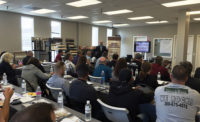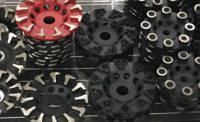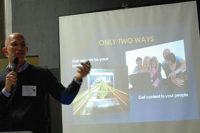Recently, more contemporary design trends with clean lines have become more and more popular. With the emergence of new products such as Lapitec, Dekton, Neolith, etc., entering the market, mitering has become extremely popular.
For Alex DiPietro, co-owner of Rye Marble in Rye, NY, he has seen mitering become prevalent amongst his customers. “I can’t speak for all fabricators but we have embraced mitering and like to do it,” said DiPietro. “We miter something nearly every day.” DiPietro said the design community likes it because it allows them control over all three dimensions of a countertop. “Current design seems to be moving towards simple, modern square shapes,” said DiPietro. “We rarely profile edges and contour radius countertops. It’s common now for us to ask, ‘How thick would you like your countertop to appear?’ We are in a very affluent market and it is an added dimension that differentiates a ‘distinguished’ kitchen from a ‘regular’ countertop. We have the ability to match counter thickness to other elements in a room.
“It is my understanding, however, that many fabricators don’t like to miter as it can be time consuming and slow down the flow of a shop,” DiPietro went on to say. “We’ve developed procedures to keep jobs moving and most importantly we charge an appropriate price.”
Joey Marcella, owner of Mario and Son, in Liberty Lake, WA, said the decision to miter an edge on stone usually comes from the architect’s or designer’s desire to “hide the lamination,” although most fabrication shops have the ability to make the lamination line in a traditional stacked lamination almost imperceptible. “Many designers make the mistake of specifying 3cm material with mitered edges, when 2cm material typically will miter better since it is able to slightly flex into position easier,” said Marcella. “The cost savings between 2 and 3 cm can be profit, or passed on to the consumer, as there is no difference in appearance in the final product, and lighter to transport and install as well.”
With the new porcelain and similar products now on the market, mitering, in many instances, is the only option that fabricators have to achieve an acceptable and thicker finished look. “Mitering these new materials is not without challenges, however, as many of these products require more specific tooling and tension relieving techniques to successfully fabricate,” said Marcella.
To help Rye Marble do different mitering jobs, DiPietro purchased an Omag 5 axis CNC saw with vacuum lifter and probes this year and it has changed their ability to miter with not only incredible precision, but also with amazing speed. “We had a very robust bridge saw before; only about 6 years old, but it could take a sawyer nearly an entire day to cut a large, mitered kitchen,” said DiPietro. “Now it’s rare that a mitered slab takes more than a half hour to cut. Also, the cuts are night and day on our CNC vs. our previous bridge saw.
“We also have the ability to automatically step cut miters so even the hardest quartzites are easily, relatively speaking, mitered,” DiPietro went on to say. “I couldn’t imagine going back to a manual setup with the amount of mitering we’re doing. But even with the latest technology, fitting miters properly is the most important part. Sometimes, a slab is not flat and the parts need to be adjusted by hand. We dry fit the job and glue it together face down. You need to have someone who knows how to tint glue. We miter a ton of white marble. Using the correct glues, not necessarily the fastest glues, is imperative for an, apparently, flawless miter. In my opinion, if you can see the glue line, there is room for improvement”
DiPietro said that another important variable in miters is the slab itself. A fabricator needs a very flat, calibrated slab for a great miter. “We import most of our material from Italy and purchase many slabs with a ‘dual finish’ which is a honed back side. Mesh backed materials are the exception,” said DiPietro. “It’s inexpensive to do so and improves quality. Another important factor to consider is proper blade use. We switch out blades on our machine multiple times per day as we switch among various materials. Our saw accepts an ISO40 cone as well and we usually keep an incremental finger bit mounted on the spindle in tandem with the blade. By having a tool holder altered by a machine shop and running 20-inch blades, we are able to miter 3cm with the finger-bit on the machine. This allows for seamless saw cycles as we use the finger bit for cutouts.”
Mitering techniques
Mitering techniques in the fabrication shop vary, as there are different ways to cut the edges. According to Marcella, having an adjustable head on a bridge saw is probably the most common, although some shops use edging machines, CNC or by cutting or grinding with manual tools. “Gluing and clamping the edge is a matter of preference as well, using mitering specific clamps available such as the Mitreforma clamps and traditional C-Clamps,” said Marcella. “Adhesive tape can also be highly effective in pulling edges together when applied with some tension. The adhesives used are the same for mitering as stacked laminations, and are a matter of preference by the fabricator.”
DiPietro said that it’s fairly easy to miter an edge with a big “roll” or radius at the top. Their goal when mitering is to keep the edge as crisp and square as the material will allow. “Never, unless requested, will a miter from Rye Marble have a pencil edge radius at the top,” said DiPietro. “Additionally, we’ve been mitering a ton of integrated sinks. Again, something that was hard to pull off when we were operating without digital equipment.”
According to DiPietro, there has been an ongoing joke in the Stone Fabricator’s Alliance (SFA) regarding the East Coast vs. West Coast mitering. “West Coast being a face up taped technique,” said DiPietro. “East Coast is faced down using squares and clamps. We work face down with great success. There are lots of discussions on mitering techniques within the SFA. We wouldn’t be where we are today without the knowledge I’ve learned from there.”








